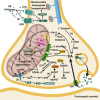Relationships between Mitochondrial Dysfunction and Neurotransmission Failure in Alzheimer's Disease
- PMID: 33014538
- PMCID: PMC7505271
- DOI: 10.14336/AD.2019.1125
Relationships between Mitochondrial Dysfunction and Neurotransmission Failure in Alzheimer's Disease
Abstract
Besides extracellular deposition of amyloid beta and formation of phosphorylated tau in the brains of patients with Alzheimer's disease (AD), the pathogenesis of AD is also thought to involve mitochondrial dysfunctions and altered neurotransmission systems. However, none of these components can describe the diverse cognitive, behavioural, and psychiatric symptoms of AD without the pathologies interacting with one another. The purpose of this review is to understand the relationships between mitochondrial and neurotransmission dysfunctions in terms of (1) how mitochondrial alterations affect cholinergic and monoaminergic systems via disruption of energy metabolism, oxidative stress, and apoptosis; and (2) how different neurotransmission systems drive mitochondrial dysfunction via increasing amyloid beta internalisation, oxidative stress, disruption of mitochondrial permeabilisation, and mitochondrial trafficking. All these interactions are separately discussed in terms of neurotransmission systems. The association of mitochondrial dysfunctions with alterations in dopamine, norepinephrine, and histamine is the prospective goal in this research field. By unfolding the complex interactions surrounding mitochondrial dysfunction in AD, we can better develop potential treatments to delay, prevent, or cure this devastating disease.
Keywords: Alzheimer’s disease; mitochondrial dysfunction; monoaminergic; neurotransmission dysfunction.
copyright: © 2020 Wong et al.
Conflict of interest statement
Declaration of Competing Interest None.
Figures





Similar articles
-
Oxidative Stress, Synaptic Dysfunction, and Alzheimer's Disease.J Alzheimers Dis. 2017;57(4):1105-1121. doi: 10.3233/JAD-161088. J Alzheimers Dis. 2017. PMID: 28059794 Free PMC article. Review.
-
GABAergic neurotransmission and new strategies of neuromodulation to compensate synaptic dysfunction in early stages of Alzheimer's disease.Front Cell Neurosci. 2014 Jun 25;8:167. doi: 10.3389/fncel.2014.00167. eCollection 2014. Front Cell Neurosci. 2014. PMID: 24987334 Free PMC article. Review.
-
Understanding How Physical Exercise Improves Alzheimer's Disease: Cholinergic and Monoaminergic Systems.Front Aging Neurosci. 2022 May 18;14:869507. doi: 10.3389/fnagi.2022.869507. eCollection 2022. Front Aging Neurosci. 2022. PMID: 35663578 Free PMC article. Review.
-
Precursor-Independent Overproduction of Beta-Amyloid in AD: Mitochondrial Dysfunction as Possible Initiator of Asymmetric RNA-Dependent βAPP mRNA Amplification. An Engine that Drives Alzheimer's Disease.Ann Integr Mol Med. 2019;1(1):61-74. Epub 2019 Nov 20. Ann Integr Mol Med. 2019. PMID: 31858090 Free PMC article.
-
Mitochondrial Dysfunction in Alzheimer's Disease: Opportunities for Drug Development.Curr Neuropharmacol. 2022;20(4):675-692. doi: 10.2174/1570159X19666210517114016. Curr Neuropharmacol. 2022. PMID: 33998995 Free PMC article.
Cited by
-
Neurotransmitters in Type 2 Diabetes and the Control of Systemic and Central Energy Balance.Metabolites. 2023 Mar 4;13(3):384. doi: 10.3390/metabo13030384. Metabolites. 2023. PMID: 36984824 Free PMC article. Review.
-
Thioredoxin-interacting protein (TXNIP) inhibition promotes retinal ganglion cell survival and facilitates M1-like microglial transformation via the PI3K/Akt pathway in glaucoma.Mol Med. 2024 Dec 30;30(1):283. doi: 10.1186/s10020-024-01058-5. Mol Med. 2024. PMID: 39736512 Free PMC article.
-
FOXO3-induced microRNA-128-3p promotes the progression of spinal cord injury in mice via regulating NLRP3 inflammasome-mediated pyroptosis.Front Immunol. 2025 Feb 21;16:1526721. doi: 10.3389/fimmu.2025.1526721. eCollection 2025. Front Immunol. 2025. PMID: 40061945 Free PMC article.
-
Hericium erinaceus Promotes Anti-Inflammatory Effects and Regulation of Metabolites in an Animal Model of Cerebellar Ataxia.Int J Mol Sci. 2023 Mar 23;24(7):6089. doi: 10.3390/ijms24076089. Int J Mol Sci. 2023. PMID: 37047062 Free PMC article.
-
Decoding Neurodegeneration: A Review of Molecular Mechanisms and Therapeutic Advances in Alzheimer's, Parkinson's, and ALS.Int J Mol Sci. 2024 Nov 24;25(23):12613. doi: 10.3390/ijms252312613. Int J Mol Sci. 2024. PMID: 39684324 Free PMC article. Review.
References
-
- Alzheimer’s Association (2018). 2018 Alzheimer’s disease facts and figures. Alzheimer’s & Dementia, 14:367-429.
-
- Prince M, Bryce R, Albanese E, Wimo A, Ribeiro W, Ferri CP (2013). The global prevalence of dementia: A systematic review and metaanalysis. Alzheimer’s & Dementia, 9:63-75.e62. - PubMed
-
- Hardy JA, Higgins GA (1992). Alzheimer’s disease: the amyloid cascade hypothesis. Science, 256:184-185. - PubMed
-
- Querfurth HW, LaFerla FM (2010). Alzheimer’s disease. N Engl J Med, 362:329-344. - PubMed
Publication types
LinkOut - more resources
Full Text Sources
